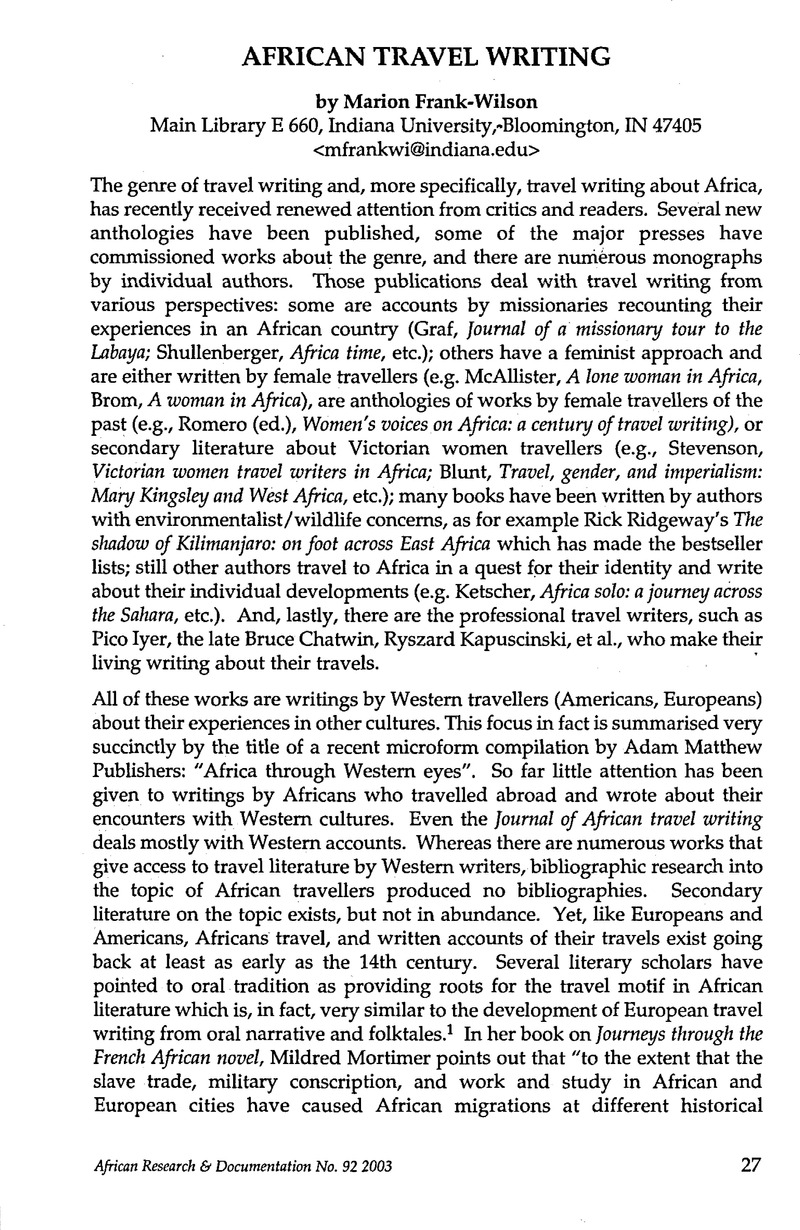No CrossRef data available.
Article contents
African travel writing
Published online by Cambridge University Press: 25 April 2022
Abstract
An abstract is not available for this content so a preview has been provided. Please use the Get access link above for information on how to access this content.

- Type
- Articles
- Information
- Copyright
- Copyright © African Research & Documentation 2003
References
Mildred, Mortimer, journeys through the French African novel. Portsmouth, NH: Heinemann, 1990.Google Scholar
Kunene, Daniel P., “Journey as metaphor in African Literature,” in African literature studies: the present state/l'état présent, ed. By Arnold, Stephen, Washington, DC, Three Continents Press, cl985.Google Scholar
Mildred Mortimer, pp. 4/5.Google Scholar
Kunene, Daniel, “Journey as metaphor in African literature,” Mildred Mortimer, journeys through the French African novel; Edith Iheakweazu, Experience abroad: African travellers discover the Western World, Enugu, Delta Publications (Nigeria) Limited, 1986.Google Scholar
David, Killingray, “African voices from two World Wars,” Historical research, 74 (186) 2001, 425-443. Many of the sources listed in the bibliography under the heading ‘African soldiers’ were found in David Killingray's article.Google Scholar
Poetry is not included.Google Scholar
Mortimer, p. 9.Google Scholar
Heike Behrend, Afrikaner Schreiben Zurueck: Texte und Bilder afrikanischer Ethnographen, Köln, Ruediger Koeppe Verlag, 1998, p. 19.Google Scholar
David, Coplan, “In the time of cannibals: the word music of South Africa's Basotho migrants,” Johannesburg, 1994, cited in Brinkman, I. , “Ethnography and literature: troubled waters and Eharo Lyahompa by Joseph Diescho,” in Behrend, H. Afrikaner Schreiben Zurueck, pp. 275-296.Google Scholar
Brinkman, I., p. 275; see also Barber, Karen , I could speak until tomorrow: Oriki, women, and the past in Yoruba Town, Edinburgh, 1991.Google Scholar
Mildred Mortimer, p. 12.Google Scholar
“Indigenous African Ethnographies”, my translationGoogle Scholar
“Local Historiographies”, my translationGoogle Scholar
Africans Write Back, my translationGoogle Scholar
Heike Behrend, p. 2.Google Scholar
See also Riesz, Janos and Joachim, Schultz (eds.). Tirailleurs Sénégalais, Frankfurt, Bern, New York, Paris, Peter Lang, 1989.Google Scholar
South Africa has experienced an increase in contact with the rest of the African continent since the end of apartheid: there has been an upsurge in migration to South Africa, and, on the other hand, South Africans travel north. One of the results of this renewed interest in Africa is “the emergence of a new stream of travel writings.” (Jonathan Crush, Tijdschrift voor Economische en Sociale Geografie, vol 91, no. 4, 2000, p. 438). One of the characteristics of this new kind of South African travel writing is that its authors seek to explain and represent the African continent to their fellow South Africans. This distinguishes it from travel writing from other parts of Africa, and it consequently is listed under a separate heading.Google Scholar
These sources were located in an article by Daniel Kunene which discusses the travel motif in African literature. The language for each of the texts is indicated in parentheses. See Daniel Kunene, “Journey as metaphor in African literature,” in African literature studies: the present state/L'état présent, ed. Arnold, Stephen, Washington, DC, Three Continents Press, cl985.Google Scholar


